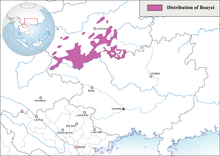Bouyei (language)
| Bouyei (布依 語) | ||
|---|---|---|
|
Spoken in |
People's Republic of China | |
| speaker | 2.6 million | |
| Linguistic classification |
|
|
| Official status | ||
| Recognized minority / regional language in |
People's Republic of China , Vietnam | |
| Language codes | ||
| ISO 639 -1 |
- |
|
| ISO 639 -2 |
tai |
|
| ISO 639-3 |
pcc |
|
Bouyei (also written Buyei or Buyi ) is the mother tongue of the Bouyei people of the same name , who live in China . It belongs to the group of the northern Tai languages within the Tai Kadai language family and is a tonal language .
Bouyei and the northern Zhuang dialects form a dialect continuum . The distinction between Zhuang and Bouyei is more administrative than linguistic. The glottolog also assumes that Bouyei and Yay (also Giáy or Nhang ), which is common in northern Vietnam, are variants or different names of the same language.
distribution

Bouyei is still spoken today by about 78.6% of the members of the people of the same name.
The Bouyei are mainly spread across the province of Guizhou . Two smaller bouyei groups in the Qiannan Autonomous District speak their own special languages, both of which also belong to the Tai Kadai languages, but are assigned to the Kam Sui branch :
- Mak (莫家 話) over 10,000 speakers;
- Ai-Cham (戛 木 話 also 唉 查 么 語) fewer than 3,000 speakers.
All other bouyei have fully assimilated to Chinese .
There were over 58,000 Giáy in Vietnam at the 2009 census. These are believed to be descended from Bouyei, who emigrated from Guizhou in the mid-19th century. The "yay" language was described in 1965 by the American linguist William J. Gedney .
Phonology and Spelling
In the 1950s, linguists created a Bouyei written language based on the Latin alphabet and based on the official transcription for Chinese, pinyin . The tones are expressed by additional consonant letters (c, f, h, j, l, q, s, t, x, y, z) at the end of the syllable.
Examples
Numerals:
| 1 | 2 | 3 | 4th | 5 | 6th | 7th | 8th | 9 | 10 | 100 | 1000 | 10,000 |
| idt | soongl / ngih | saaml | sis | hac | rogt | xadt | beedt | guz | xib | bas | xianl | faanh |
literature
- Wil C. Snyder: Bouyei Phonology. In: The Tai-Kadai Languages. Routledge, Oxford / New York 2008, pp. 378–388.
Individual evidence
- ^ Yongxian Luo: The Subgroup Structure of the Tai Languages. A Historical-Comparative Study. University of California, Berkeley 1997, p. 40.
- ^ David Bradley: Languages of Mainland South-East Asia. In: The Vanishing Languages of the Pacific Rim. Oxford University Press, Oxford / New York 2007, pp. 301–336, at p. 310.
- ↑ Yongxian Luo: Zhuang. In: The Tai-Kadai Languages. Routledge, London / New York 2008, pp. 317-377, at pp. 318-319.
- ↑ Harald Hammarström et al. a. (Ed.): Glottolog. Version 4.1. Entry Bouyei . Retrieved February 7, 2020.
- ↑ Jerold A. Edmondson, Kenneth J. Gregerson: Four Languages of the Vietnam-China Borderlands. In: KL Adams and TJ Hudak: Papers from the Sixth Annual Meeting of the Southeast Asian Linguistics Society. Arizona State University, Program for Southeast Asian Studies, Tempe (AZ) 2001, pp. 101-133, at p. 123.